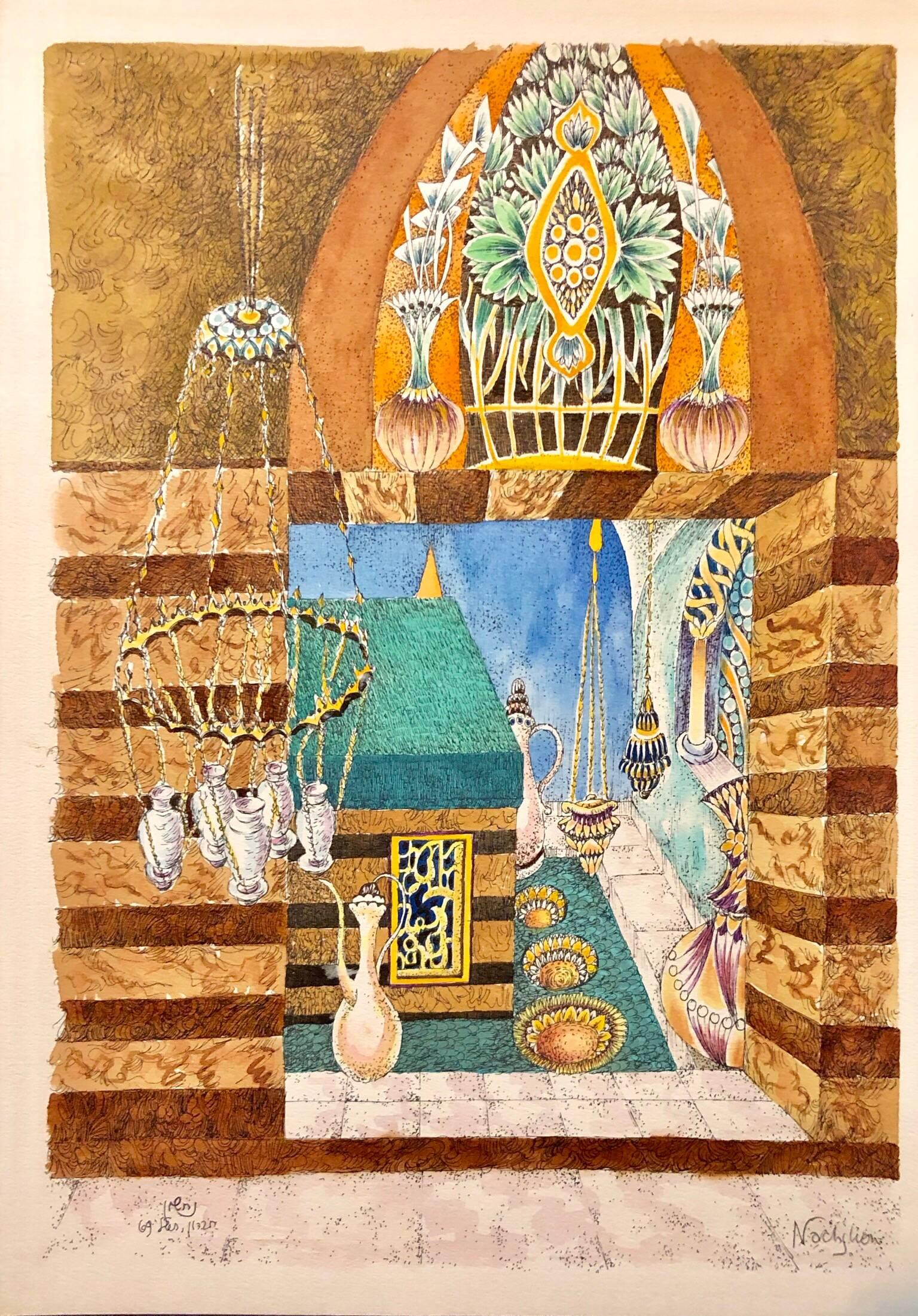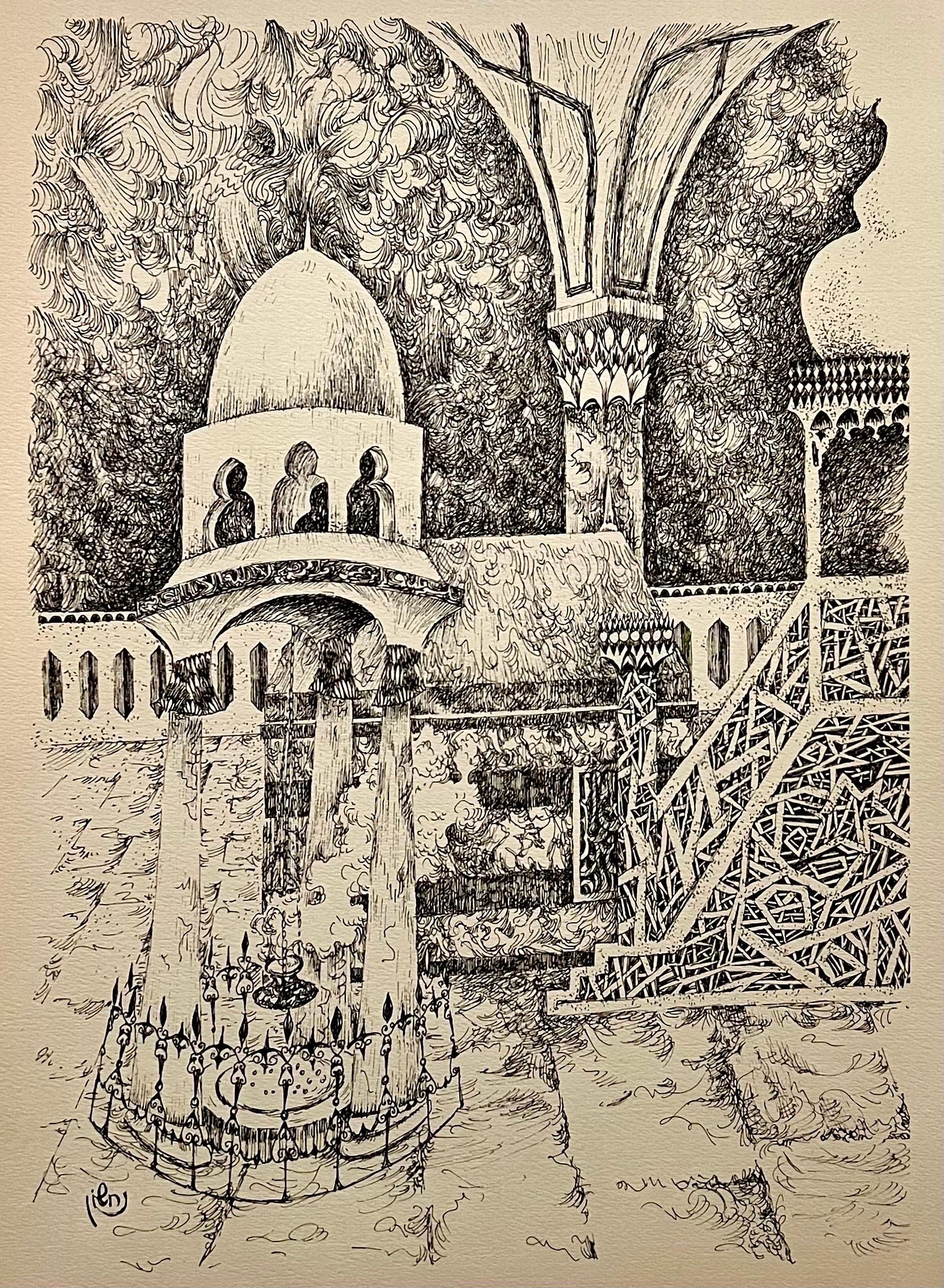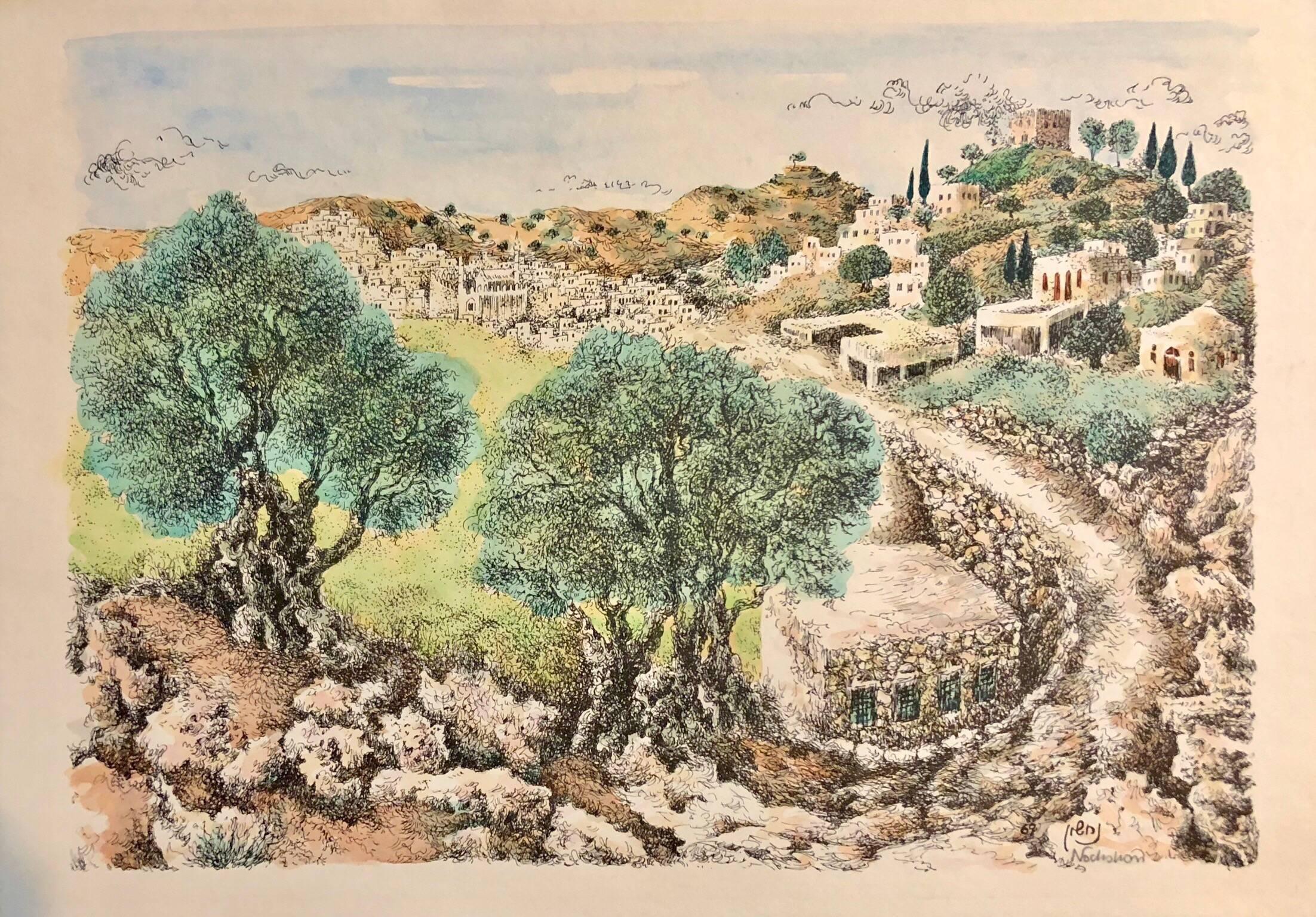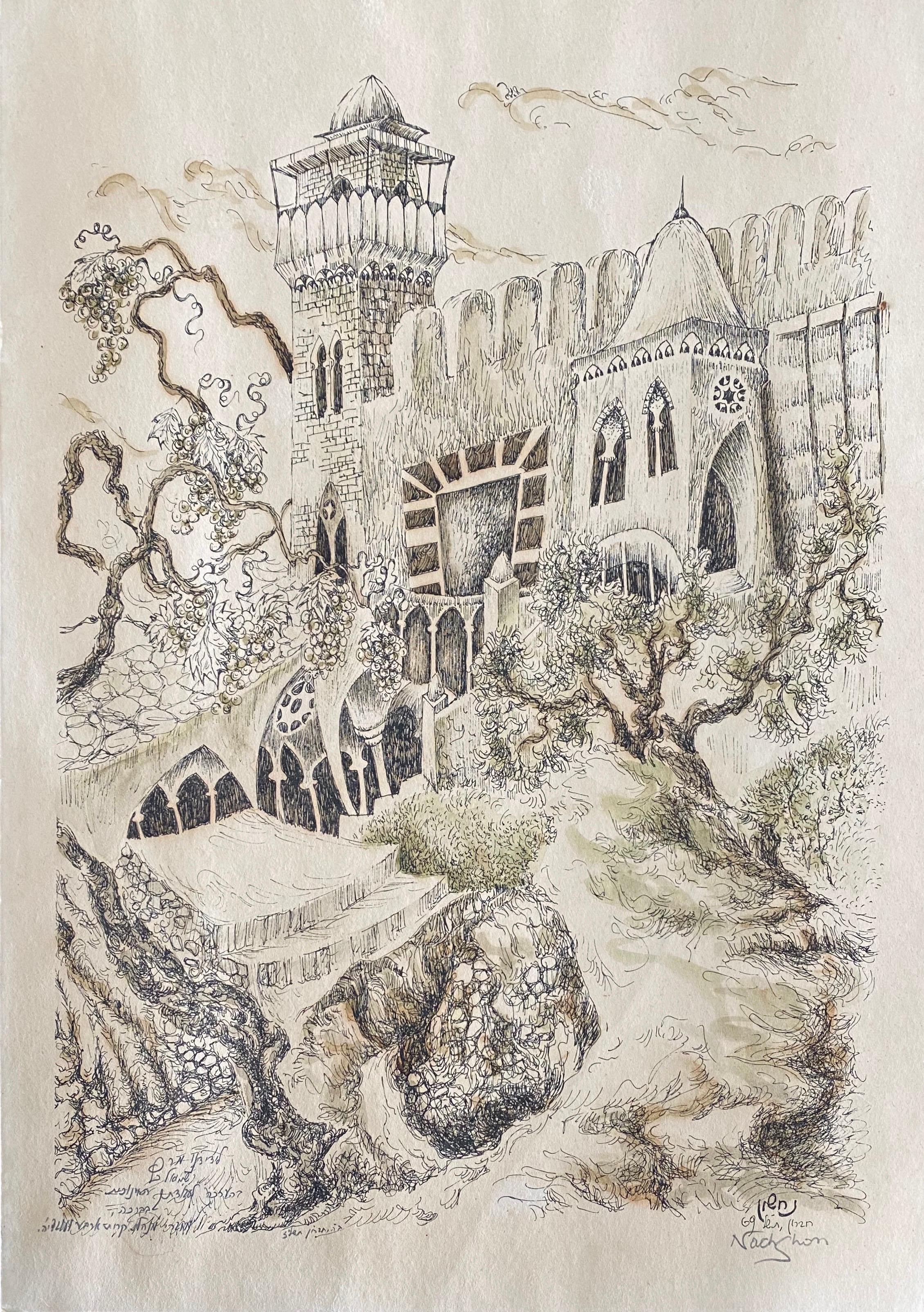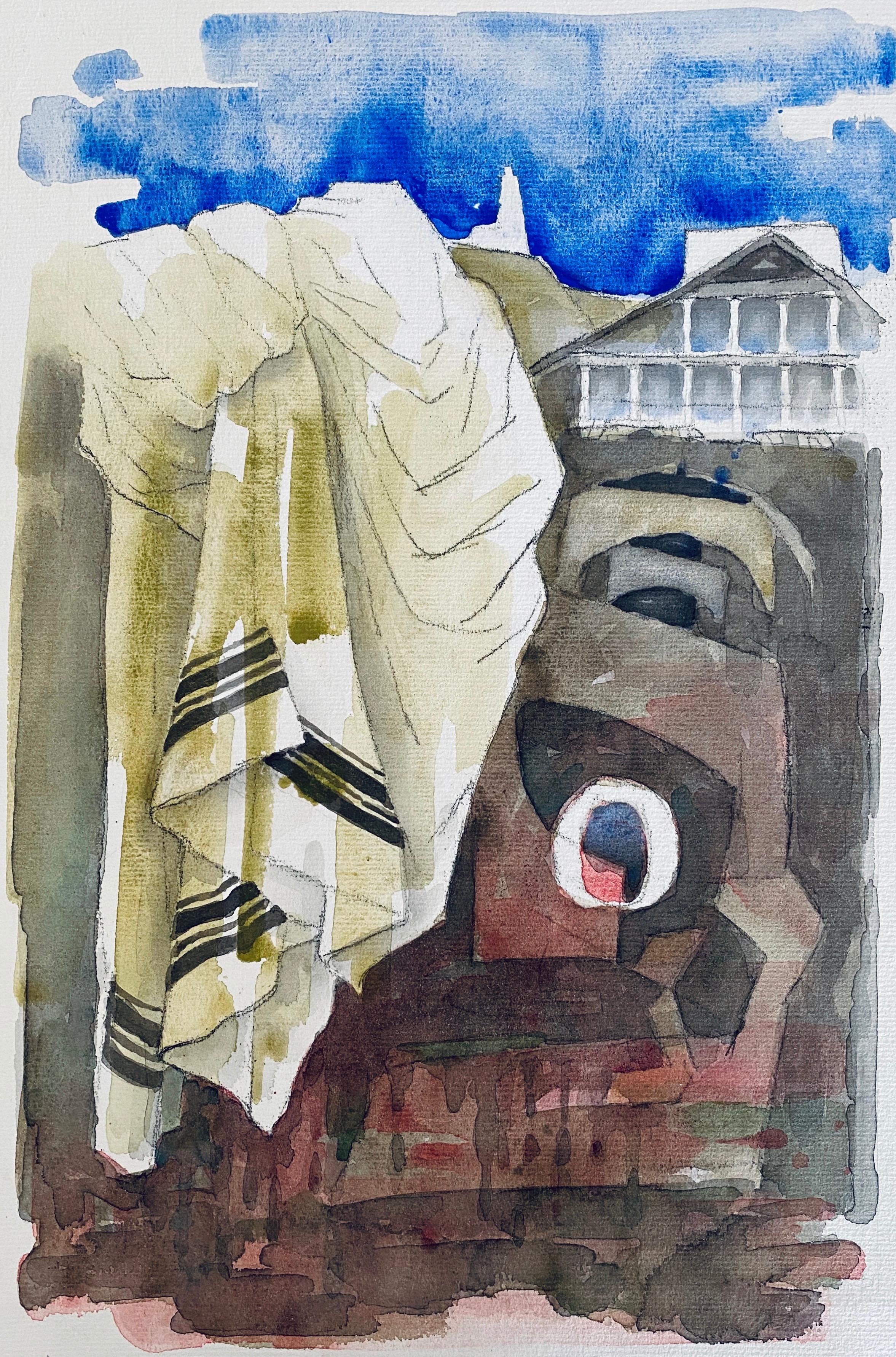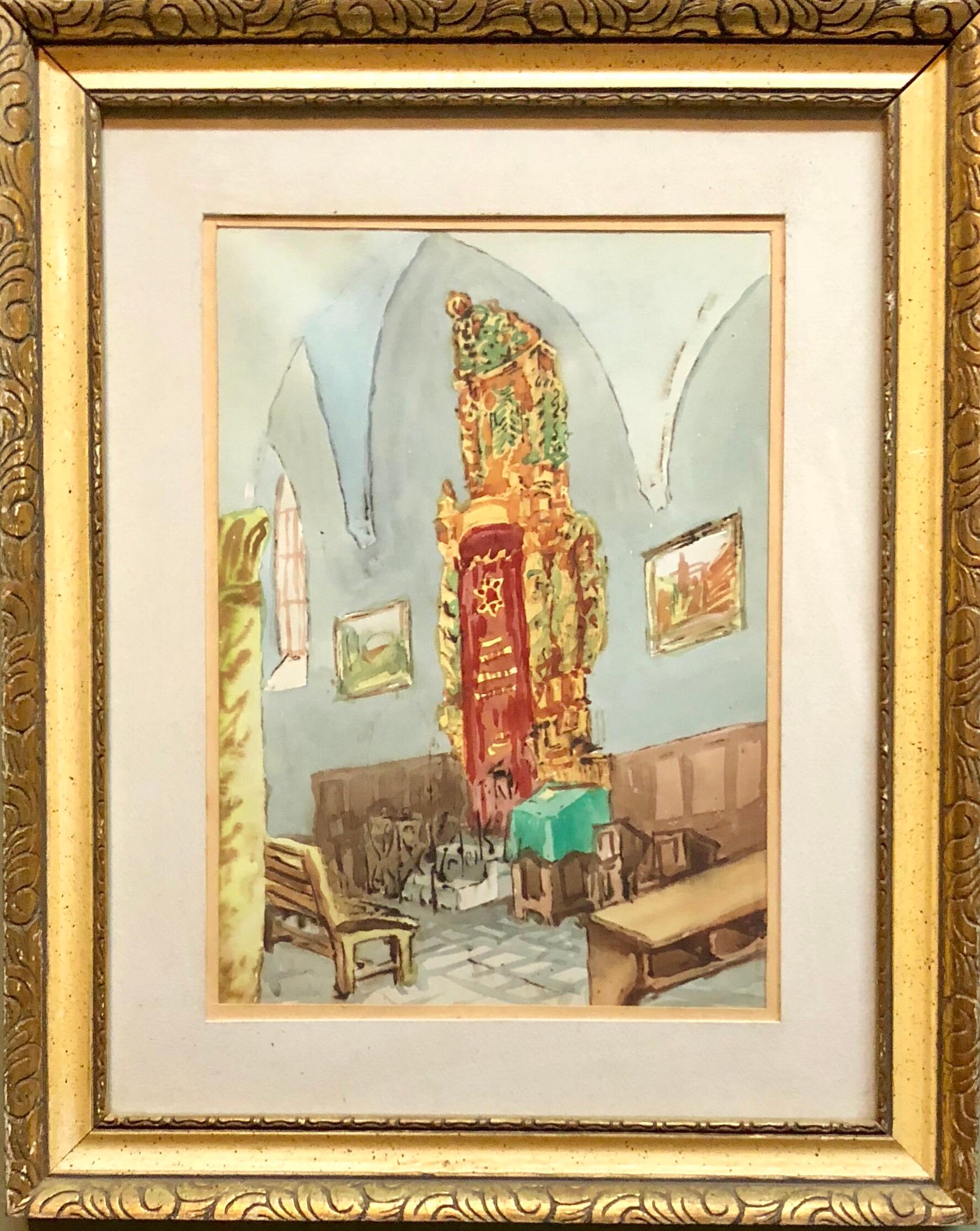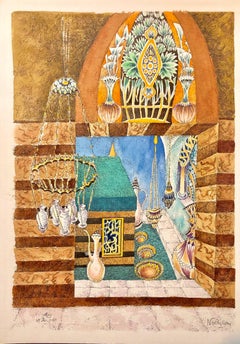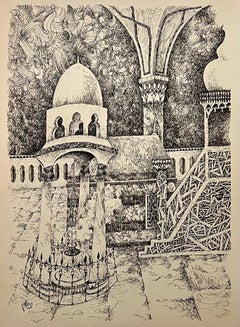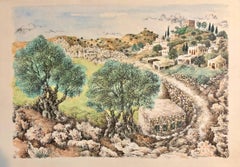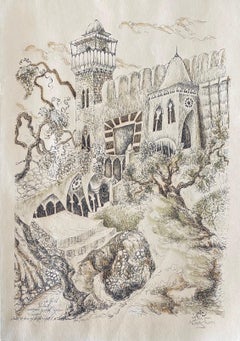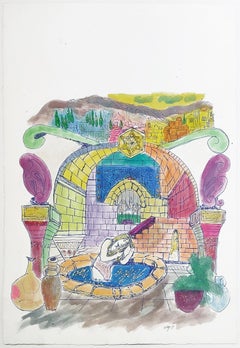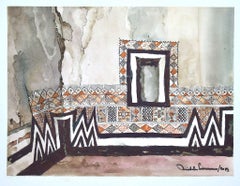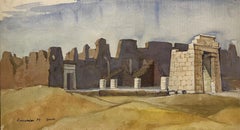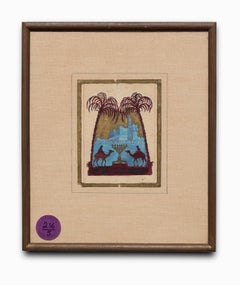Items Similar to Machpela Cave Chevron 1969 Israeli Judaica Mixed Media Print Watercolor Painting
Want more images or videos?
Request additional images or videos from the seller
1 of 9
Baruch NachshonMachpela Cave Chevron 1969 Israeli Judaica Mixed Media Print Watercolor Painting1969
1969
$1,200
£910.53
€1,041.11
CA$1,676.07
A$1,863.57
CHF 973.05
MX$22,684.15
NOK 12,415.72
SEK 11,632.93
DKK 7,770.01
Shipping
Retrieving quote...The 1stDibs Promise:
Authenticity Guarantee,
Money-Back Guarantee,
24-Hour Cancellation
About the Item
Baruch Nachshon, was born in Mandatory Palestine in 1939, in the city of Haifa.
Nachshon began to paint in early childhood, and developed his relationship to art and to artists throughout his youth. During his military service Nachshon herded flocks for the IDF, an experience that imbued in him a love and appreciation for nature which figures prominently in his work until today. Upon completing his military service the young artist was torn between the temptation to travel to Paris, then the cultural center of the art world, and his deep love of the land of Israel, the spiritual center of the Jewish world. Opting to stay in Israel, Nachshon studied under Shlomo Nerani, Cezanne’s only pupil, with whom he had enjoyed a deep friendship extending back to his childhood. Nachshon, whom Nerani viewed as his spiritual heir, was the only one of his students allowed to see the master at work.
Nachshon’s lifelong involvement in Lubavitch Hassidut began in his early adulthood, when he was drawn to the movement by its uniquely beautiful traditional melodies. In 1965 Nachshon was invited to an unprecedented three- hour private session with the Rebbe of Lubavitch, Menachem Mendel Schneerson, in New York. The young artist used the opportunity to share his concerns and misgivings about the role of the Jewish artist and the many inherent conflicts which confronted him. The Rebbe blessed Nachshon with the advice that for many generations the art of painting had failed to find its ultimate rectification in holiness, but that with the help of God he might come to bring about that long anticipated rectification. The Rebbe then offered to fund Nachshon’s studies in New York on the condition that he would find a program of study acceptable to Jewish religious values. Despite the difficulty inherent in such a task, Nachshon gladly received the Rebbe’s offer and devoted himself fully to the celebration of the wisdom of the Creator through visual art.
In 1967 Nachshon and his wife Sara, along with six other families renewed the Jewish presence in Hebron for the first time since the city’s Jewish residents were massacred by Arabs in 1929. To underscore the significance of Jewish culture to the city, Nacshon opened a gallery of his art beside the Tomb of the Patriarchs. During this period Nachshon also used to visit the houses of Hebron’s Arab residents in order to paint the city from unique angles. On one of his regular visits to the Tomb of the Patriarchs, Nachshon met an elderly Breslov Hassid. The hassid urged him to recite Psalms every night for forty days, and assured him that if he did so he would merit profound revelation. Nachshon did so, and as soon as the forty days had passed he saw the heavens open, receiving visions that would charge his art forever. Since that first time, Nachshon has seen the heavens open many times and, indeed, the opening of the heavens is a recurring motif in his work. According to Nachshon, “the open sky means going beyond what is reality, seeing through.”
Nachshon’s art covers a wide range of thematic material through equally diverse stylistic approaches, all of which are uniquely his own. He paints in order to define and to emphasize the presence of the active Divine Will in creation, and in order to inspire himself and others. Nachshon paints what he sees through the eyes of an inspired painter, communicating those visions to the world. Each of his paintings can be studied in the manner of a sacred text, providing numerous and vivid insights into the workings of creation and the promises held for the future. Many of his paintings describe visions of the future, of the world after its final redemption, of a world where all is peace and joy and where the revelation of divine beneficence is clear to all. Until that time, Nachshon’s paintings offer a glimpse of what could be, of what ought to be and of what will be when the work of humanity has reached its successful completion
The Artist’s Prayer
I express my gratitude to you, artisan of creation, for you have endowed me with the spirit of your holy inspiration.
I beseech you- in your vast kindness- impart to me more and more of your holy inspiration so that I may rejoice in you, and give cause for rejoicing to your creations. Give me inspiration to reveal your presence, even in the darkest places, because everything is from you and before your presence all darkness is also light. You created your universe, and within it crafted all of your creatures so that they would come to acknowledge you.
And so- this, indeed is all I ask- kindness! For there is nothing else, no words in our mouths sufficient to thank you for having created us, having made us your children- the Children of Israel- and having brought us close to you in order to serve you. You have drawn forth our spirit and illuminated all- Well of Life.
-Baruch Nachshon, Hebron, 5749
Participated in group exhibitions in the Artists' Quarter in Safed, Tel Aviv, Jerusalem, in the Chai Gallery, Chabad Chassidic Art Institute in Brooklyn, and in other art galleries in Brooklyn. Championed by the Chai Gallery in Crown Heights, Brooklyn New York, they have represented all of the major Lubavitch Hasidic artists such as Baruch Nachshon, Hendel Lieberman, Zalman Kleinman, Michoel Muchnik as well as artists such as Samuel Rothbort, Harry Mccormick, Meer Akselrod and the Rebbe photos of Fridrich Vishinsky.
- Creator:Baruch Nachshon (1939, Israeli)
- Creation Year:1969
- Dimensions:Height: 19 in (48.26 cm)Width: 13.25 in (33.66 cm)
- Medium:
- Movement & Style:
- Period:
- Condition:
- Gallery Location:Surfside, FL
- Reference Number:1stDibs: LU38212940792
About the Seller
4.9
Platinum Seller
Premium sellers with a 4.7+ rating and 24-hour response times
Established in 1995
1stDibs seller since 2014
1,784 sales on 1stDibs
Typical response time: <1 hour
- ShippingRetrieving quote...Shipping from: Surfside, FL
- Return Policy
Authenticity Guarantee
In the unlikely event there’s an issue with an item’s authenticity, contact us within 1 year for a full refund. DetailsMoney-Back Guarantee
If your item is not as described, is damaged in transit, or does not arrive, contact us within 7 days for a full refund. Details24-Hour Cancellation
You have a 24-hour grace period in which to reconsider your purchase, with no questions asked.Vetted Professional Sellers
Our world-class sellers must adhere to strict standards for service and quality, maintaining the integrity of our listings.Price-Match Guarantee
If you find that a seller listed the same item for a lower price elsewhere, we’ll match it.Trusted Global Delivery
Our best-in-class carrier network provides specialized shipping options worldwide, including custom delivery.More From This Seller
View AllMachpela Cave Chevron 1967 Israeli Judaica Mixed Media Print Watercolor Painting
By Baruch Nachshon
Located in Surfside, FL
Baruch Nachshon, was born in Mandatory Palestine in 1939, in the city of Haifa.
Nachshon began to paint in early childhood, and developed his relationship to art and to artists throu...
Category
1960s Modern Landscape Drawings and Watercolors
Materials
Watercolor
Machpela Cave Chevron 1969 Israeli Judaica Lithograph Baruch Nachshon Chabad Art
By Baruch Nachshon
Located in Surfside, FL
Baruch Nachshon, was born in Mandatory Palestine in 1939, in the city of Haifa.
Nachshon began to paint in early childhood, and developed his relationship to art and to artists throu...
Category
1960s Modern Interior Prints
Materials
Lithograph
Hebron, 1967 Israeli Judaica Mixed Media Print Watercolor Painting
By Baruch Nachshon
Located in Surfside, FL
Baruch Nachshon, was born in Mandatory Palestine in 1939, in the city of Haifa.
Nachshon began to paint in early childhood, and developed his relationship to art and to artists throu...
Category
20th Century Modern Landscape Drawings and Watercolors
Materials
Watercolor
Hebron, 1969 Israeli Judaica Mixed Media Lithograph With Watercolor
By Baruch Nachshon
Located in Surfside, FL
Baruch Nachshon, was born in Mandatory Palestine in 1939, in the city of Haifa.
Nachshon began to paint in early childhood, and developed his relationship to art and to artists throu...
Category
20th Century Modern Landscape Drawings and Watercolors
Materials
Watercolor, Lithograph
Polish French Judaica Watercolor Gouache Painting Original Bauhaus Yiddish Art
By Moses Bagel Bahelfer
Located in Surfside, FL
Moses Bahelfer BAGEL (1908-1995)
Moses Bagel (born Moshe Bahelfer) was a Polish-born Jewish artist and graphic designer associated with the original Bauhaus and then the School of Pa...
Category
20th Century Modern Figurative Drawings and Watercolors
Materials
Ink, Watercolor, ABS
Israeli Modernist Safed Synagogue Interior Folk Art Watercolor Painting
By Zvi Ehrman
Located in Surfside, FL
In this piece the artist choice of colors is vibrant, and there is minimal blending of them. The artist takes a naive, Folk Art approach at rendering the subject simplifying the figu...
Category
Mid-20th Century Modern Landscape Drawings and Watercolors
Materials
Paper, Watercolor
You May Also Like
WOMAN IN POOL (JUDAICA ART)
By Amram Ebgi
Located in Aventura, FL
Original watercolor and glitter on paper. Hand signed on front by the artist. Sheet size 21.75 x 15 inches.
Artwork is in excellent condition. Certificate of authenticity included. ...
Category
2010s Contemporary Figurative Drawings and Watercolors
Materials
Paper, Glitter, Watercolor
$275 Sale Price
50% Off
Morocco - Original Watercolor by Michele Cascarano - 2015
By Michele Cascarano
Located in Roma, IT
Morocco is an original drawing in Watercolor on paper applied on cardboard. realized by Michele Cascarano.
The state of preservation of the artwork is excellent.
Hand-signed and da...
Category
2010s Naturalistic Figurative Drawings and Watercolors
Materials
Paper, Watercolor
"Dush" Landscape Watercolor Painting 9" x 17" inch (1974) by Zaccaria Zeini
Located in Culver City, CA
"Dush" Landscape Watercolor Painting 9" x 17" inch (1974) by Zaccaria Zeini
Medium: watercolor on paper
Signed and dated
Zaccaria El Zeini (1932 - 1993) was raised in the popular ...
Category
20th Century Landscape Paintings
Materials
Paper, Watercolor
"Song of Songs Illustration" Watercolor, Old Testament Story, Colors
Located in Detroit, MI
SALE ONE WEEK ONLY
"Song of Songs Watercolor" renders an important bibilical story that is celebrated during Jewish Passover. Song of Solomon, also called Canticle of Canticles, or Song of Songs, an Old Testament...
Category
Mid-20th Century Other Art Style Landscape Drawings and Watercolors
Materials
Paper, Watercolor
PLAYHOUSE (JUDAICA ART)
By Amram Ebgi
Located in Aventura, FL
Lithograph in colors on paper. Hand signed and numbered by the artist. From the edition of 350.
Artwork is in excellent condition. Certificate of authenticity included. All reason...
Category
Late 20th Century Contemporary Figurative Prints
Materials
Paper, Lithograph
$100 Sale Price
50% Off
"Song of Songs Illustration" Old Testament, Watercolor
Located in Detroit, MI
SALE ONE WEEK ONLY
"Song of Songs Illustration" renders an important bibilical story that is celebrated during Jewish Passover. Song of Solomon, also called Canticle of Canticles, or Song of Songs, an Old Testament...
Category
Mid-20th Century Other Art Style Animal Drawings and Watercolors
Materials
Paper, Watercolor
